- Home
- Prelims
- Mains
- Current Affairs
- Study Materials
- Test Series
 EDITORIALS & ARTICLES
EDITORIALS & ARTICLES
Earth’s atmosphere
- Earth’s original atmosphere was probably just hydrogen and helium, because these were the main gases in the dusty, gassy disk around the Sun from which the planets formed. The Earth and its atmosphere were very hot. Molecules of hydrogen and helium move really fast, especially when warm. Actually, they moved so fast they eventually all escaped Earth''s gravity and drifted off into space.
- Earth’s atmosphere is composed of about 78% nitrogen, 21% oxygen, and 0.93% argon. The remainder, less than 0.1%, contains such trace gases as water vapor, carbon dioxide, and ozone. All of these trace gases have important effects on Earth’s climate. The atmosphere can be divided into vertical layers determined by the way temperature changes with altitude. The layer closest to the surface is the troposphere, which contains over 80% of the atmospheric mass and nearly all the water vapor. The next layer, the stratosphere, contains most of the atmosphere’s ozone, which absorbs high-energy radiation from the sun and makes life on the surface possible. Above the stratosphere are the mesosphere and thermosphere. These two layers include regions of charged atoms and molecules, or ions. The upper mesosphere and lower thermosphere are called the ionosphere, this region is important to radio communications, because radio waves can bounce off the layer and travel great distances. It is thought that the present atmosphere developed from gases ejected by volcanoes. Oxygen, upon which all animal life depends, probably accumulated as excess emissions from plants that produce it as a waste product during photosynthesis. Human activities may be affecting the levels of some important atmospheric components, particularly carbon dioxide and ozone.
Composition of the atmosphere
Major gases
- The most common atmospheric gas, nitrogen (chemical symbol N2) is largely inert, meaning that it does not readily react with other substances to form new chemical compounds. The next most common gas, oxygen (O2), is required for the respiration (breathing) of all animal life on Earth, from humans to bacteria. In contrast to nitrogen, oxygen is extremely reactive. It participates in oxidation, examples of which include apples turning from white to brown after being sliced, the rusting of iron, and the very rapid oxidation reaction known as fire. Just under 1% of the atmosphere is made up of argon (Ar), which is an inert noble gas, meaning that it does not take part in any chemical reactions under normal circumstances. Together, these three gases account for 99.96% of the atmosphere. The remaining 0.04% contains a wide variety of trace gases, several of which are crucial to life on Earth.
Important trace gases
- Carbon dioxide (CO2) affects Earth’s climate and plays a large support role in the biosphere, the collection of living things that populate Earth’s surface. Only about 0.0325% of the atmosphere is CO2. Carbon dioxide is required by plant life for photosynthesis, the process of using sunlight to store energy as simple sugars, upon which all life on Earth depends. Carbon dioxide is also one of a class of compounds called greenhouse gases. These gases are made up of molecules that absorb and emit infrared radiation, which is felt as heat. The solar energy radiated from the sun is mostly in the visible range, within a narrow band of wavelengths. This radiation is absorbed by Earth’s surface, then re-radiated back out to space not as visible light, but as longer wavelength infrared radiation. Greenhouse gas molecules absorb some of this radiation before it escapes to space, and re-emit some of it back toward the surface. In this way, these gases trap some of the escaping heat and increase the overall temperature of the atmosphere. If the atmosphere had no greenhouse gases, it is estimated that Earth’s surface would be 90°F (32°C) cooler.
- Water vapor (H2 O) is found in the atmosphere in small and highly variable amounts. While it is nearly absent in most of the atmosphere, its concentration can range up to 4% in very warm, humid areas close to the surface. Despite its relative scarcity, atmospheric water probably has more of an impact on Earth than any of the major gases, aside from oxygen. Water vapor is an element of the hydrologic cycle, the process that moves water between the oceans, the land surface waters, the atmosphere, and the polar ice caps. Water cycling drives erosion and rock weathering, determines Earth’s weather, and sets up climate conditions that make land areas dry or wet, habitable or inhospitable. When cooled sufficiently, water vapor forms clouds by condensing to liquid water droplets, or, at lower temperatures, solid ice crystals. Besides creating rain or snow, clouds affect Earth’s climate by reflecting some of the energy coming from the sun, making the planet somewhat cooler. Water vapor is also an important greenhouse gas. It is concentrated near the surface and is much more prevalent near the tropics than in the polar regions.
- Ozone (O3) is found almost exclusively in a layer about 9–36 mi (15–60 km) in altitude. At lower altitudes, ozone gas is irritating to eyes and skin and chemically attacks rubber and plant tissue. Nevertheless, it is vital to life on Earth because it absorbs most of the high-energy radiation from the sun that is harmful to plants and animals. A portion of the energy radiated by the sun lies in the ultraviolet (UV) region. This shorter wavelength radiation is responsible for suntans and is sufficiently powerful to harm cells, cause skin cancer, and burn skin. The ozone molecules, along with molecules of O2, absorb nearly all the high-energy UV rays, protecting Earth’s surface from the most damaging radiation. The first step in this process occurs high in the atmosphere, where O2 molecules absorb very high energy UV radiation. Upon doing so, each absorbing molecule breaks up into two oxygen atoms. The oxygen atoms eventually collide with another O2 molecule, forming a molecule of ozone, O3 (a third molecule is required in the collision to carry away excess energy). Ozone in turn may absorb UV of slightly longer wavelength, which removes one of its oxygen atoms and leaves O2. The free oxygen atom, being very reactive, will almost immediately recombine with another O2, forming more ozone. The last two steps of this cycle repeat themselves but do not create any new chemical compounds; they only act to absorb ultraviolet radiation. The amount of ozone in the stratosphere is small. If it were all transported to the surface, the ozone gas would form a layer about 0.1–0.16 in (2.5–4.0 mm) thick. This layer, as thin as it is, is sufficient to shield Earth’s occupants from harmful solar radiation.
Aerosols
- In addition to gases, the atmosphere has a wide variety of suspended particles known collectively as aerosols. These particles may be liquid or solid and are small enough that they may require very long times to settle out of the atmosphere by gravity. Examples of aerosols include suspended soil or desert sand particles, smoke particles from wildfires, salt particles from evaporated ocean water, plant pollen, volcanic dust, and particles formed from the pollution created by coal burning power plants. Aerosols significantly affect atmospheric heat balance, cloud growth, and optical properties.
- The particles in aerosols cover a wide range of sizes. Raindrops suspended in a cloud are about 0.04–0.24 in (1–6 mm) in diameter. Fine desert sand and cloud droplets range in diameter down to about 0.0004 in (0.01 mm). Sea salt particles and smoke particles are 1/100th of this, about 0.0001 mm, or 0.1 micrometer, in diameter (1 micrometer = one thousandth of a millimeter). Smallest of all are the particles that form when certain gases condense—that is, when several gas molecules come together to form a stable cluster. These are the Aitkin nuclei, whose diameters can be measured down to a few nanometers (1 nanometer = one millionth of a millimeter).
- The size of some aerosol particles allows them to efficiently scatter sunlight and create atmospheric haze. Under some conditions, aerosols act as collecting points for water vapor molecules, encouraging the growth of cloud droplets and speeding the formation of clouds. They may also play a role in Earth’s climate. Aerosols are known to reflect a portion of incoming solar radiation back to space, which lowers the temperature of Earth’s surface. Current research is focused on estimating how much cooling is provided by aerosols, as well as how and when aerosols form in the atmosphere.
Atmospheric structure
- The atmosphere can be divided into layers based on the atmospheric pressure and temperature profiles (the way these quantities change with height). Atmospheric temperature drops steadily from its value at the surface, about 290K (63°F; 17°C), until it reaches a minimum of around 220K (–64°F;–53°C) at 6 mi (10 km) above the surface. This first layer is called the troposphere and ranges in pressure from over 1,000 millibars at sea level to 100 millibars at the top of the layer, the tropopause. Above the tropopause, the temperature rises with increasing altitude up to about 27 mi (45 km). This region of increasing temperatures is the stratosphere, spanning a pressure range from 100 millibars at its base to about 10 millibars at the stratopause, the top of the layer. Above 30 mi (50 km), the temperature resumes its drop with altitude, reaching a very cold minimum of 180K (–135°F;–93°C) at around 48 mi (80 km). This layer is the mesosphere, which at its top (the mesopause) has an atmospheric pressure of only 0.01 millibars (that is, only 1/100,000th of the surface pressure). Above the mesosphere lies the thermosphere, extending hundreds of miles upward toward the vacuum of space. It is not possible to place an exact top of the atmosphere because air molecules become scarcer until the atmosphere blends with the material found in space.
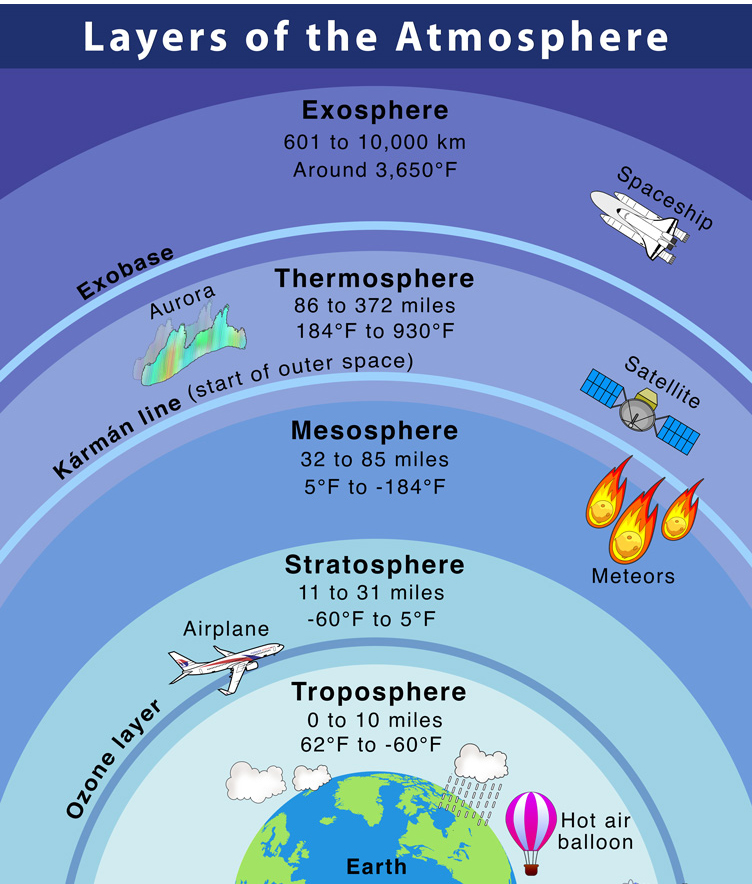
The troposphere
- The troposphere contains over 80% of the mass of the atmosphere, along with nearly all of the water vapor. This layer contains the air we breathe, the winds we observe, and the clouds that bring our rain. All of what we know as weather occurs in the troposphere, the name of which means “changing sphere.” All of the cold fronts, warm fronts, high and low pressure systems, storm systems, and other features seen on a weather map occur in this lowest layer. Severe thunderstorms may penetrate the tropopause.
- Within the troposphere, temperature decreases with increasing height at an average rate of about 11.7°F per every 3,281 ft (6.5°C per every 1,000 meters). This quantity is known as the lapse rate. When air begins to rise, it will expand and cool at a faster rate determined by the laws of thermodynamics. This means that if a parcel of air begins to rise, it will soon find itself cooler and denser than its surroundings, and will sink back downward. This is an example of a stable atmosphere in which vertical air movement is prevented. Because air masses move within the troposphere, a cold air mass may move into an area and have a higher lapse rate. That is, its temperature falls off more quickly with height. Under these weather conditions, air that begins rising and cooling will become warmer than its surroundings. It then is like a hot-air balloon: it is less dense than the surrounding air and buoyant, so it will continue to rise and cool in a process called convection. If this is sustained, the atmosphere is said to be unstable, and the rising parcel of air will cool to the point where its water vapor condenses to form cloud droplets. The air parcel is now a convective cloud. If the buoyancy is vigorous enough, a storm cloud will develop as the cloud droplets grow to the size of raindrops and begin to fall out of the cloud as rain. Thus, under certain conditions the temperature profile of the troposphere makes possible storm clouds and precipitation.
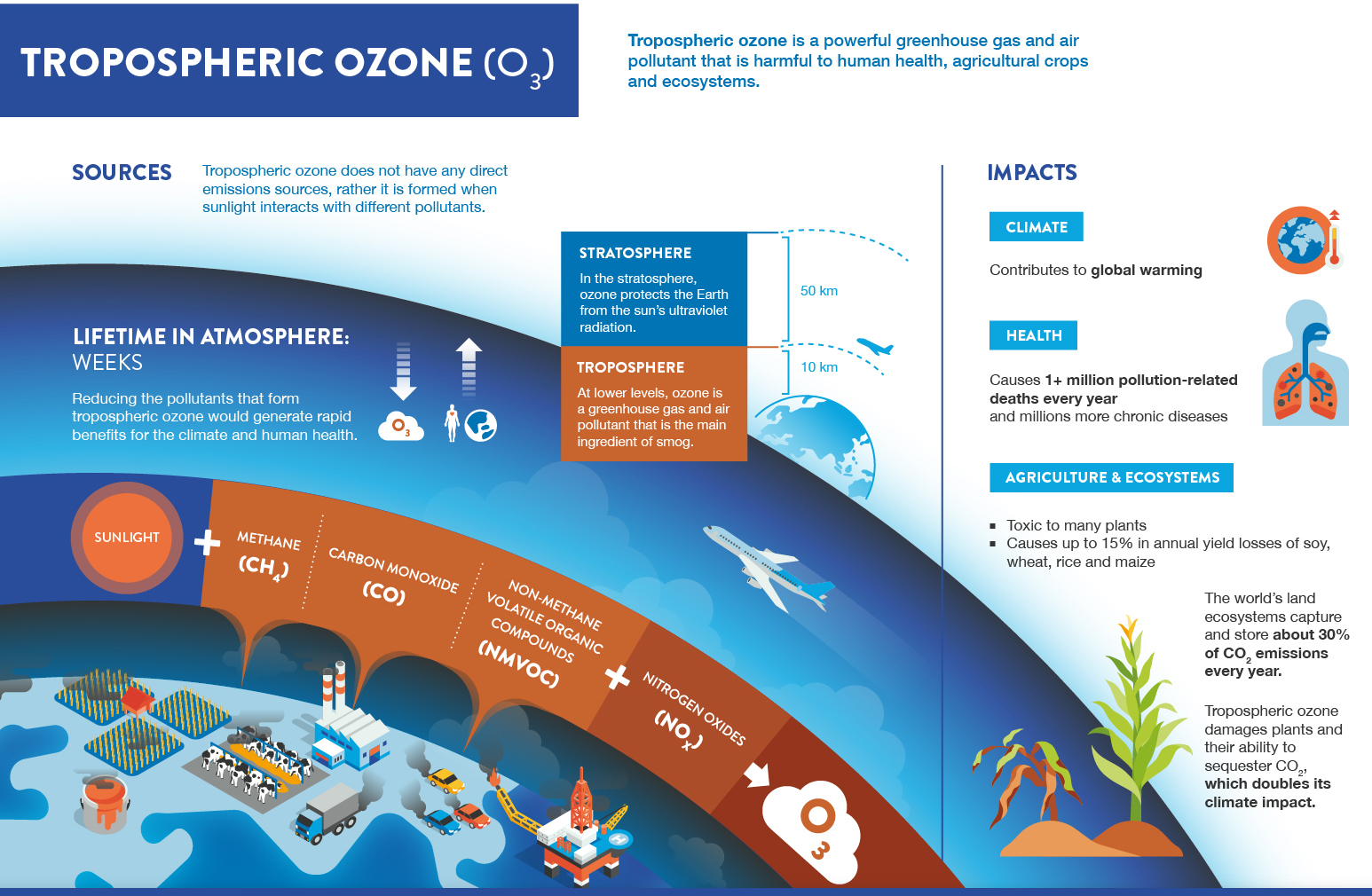
- During a strong thunderstorm, cumulonimbus clouds (the type that produce heavy rain, high winds, and hail) may grow tall enough to reach or extend into the tropopause. Here they run into strong stratospheric winds, which may shear off the top of the clouds and stop their growth. One can see this effect in the anvil clouds associated with strong summer thunderstorms.
The stratosphere
- The beginning of the stratosphere is defined as that point where the temperature reaches a minimum and the lapse rate abruptly drops to zero. This temperature structure has one important consequence: it inhibits rising air. Any air that begins to rise will become cooler and denser than the surrounding air. The stratosphere is therefore very stable.
- The stratosphere contains most of the ozone found in Earth’s atmosphere, and the presence of ozone is the reason for the temperature profile found in the stratosphere. Ozone and oxygen gas both absorb short wave solar radiation. In the series of reactions that follow, heat is released. This heat warms the atmosphere in the layer at about 12–27 mi (20–45 km) and gives the stratosphere its characteristic temperature increase with height.
- The ozone layer has been the subject of concern. In 1985, scientists from the British Antarctic Survey noticed that the amount of stratospheric ozone over the South Pole fell sharply during the spring months, recovering somewhat as spring turned to summer. An examination of the historical records revealed that the springtime ozone losses had begun around the late 1960s and had grown much more severe by the late 1970s. By the mid-1980s virtually all the ozone was disappearing from parts of the polar stratosphere during the late winter and early spring. These ozone losses, dubbed the ozone hole, were the subject of intense research both in the field and in the laboratory.
- Although the stratosphere has very little water, clouds of ice crystals may form at times in the lower stratosphere over the polar regions. Early Arctic explorers named these clouds nacreous or mother-of-pearl clouds because of their iridescent appearance. More recently, very thin and widespread clouds have been found to form in the polar stratosphere under extremely cold conditions. These clouds, called polar stratospheric clouds, or PSCs, appear to be small crystals of ice or frozen mixtures of ice and nitric acid. PSCs play a key role in the development of the ozone hole.
- The understanding that has emerged implicates chlorine as the chemical responsible for ozone destruction in the ozone hole. Chlorine apparently gets into the stratosphere from chlorofluorocarbons, or CFCs—industrial chemicals widely used as refrigerants, aerosol propellants, and solvents. Laboratory experiments show that after destroying an ozone molecule, chlorine is tied up in a form unable to react with any more ozone. However, it can chemically react with other chlorine compounds on the surfaces of polar stratospheric cloud particles, which frees the chlorine to attack more ozone. In other words, each chlorine molecule is recycled many times so that it can destroy thousands of ozone molecules. The realization of chlorine’s role in ozone depletion brought about an international agreement in 1987, the Montreal Protocol, which committed the participating industrialized countries to begin phasing out CFCs.
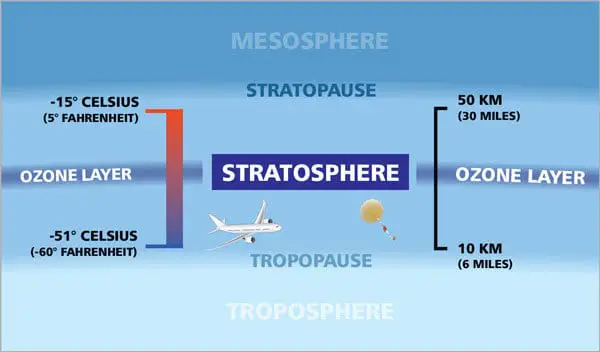 The mesosphere and thermosphere
The mesosphere and thermosphere
- The upper mesosphere and the lower thermosphere contain charged atoms and molecules (ions) in a region known as the ionosphere. The atmospheric constituents at this level include nitrogen gas, atomic oxygen, nitrogen (O and N), and nitric oxide (NO). All of these are exposed to strong solar emission of ultraviolet and x-ray radiation, which can result in ionization, knocking off an electron to form an atom or molecule with a positive charge. The ionosphere is a region enriched in free electrons and positive ions. This charged particle region affects the propagation of radio waves, reflecting them as a mirror reflects light. The ionosphere makes it possible to tune in radio stations very far from the transmitter. Even if the radio waves coming directly from the transmitter are blocked by mountains or the curvature of Earth, one can still receive the waves bounced off the ionosphere. After the sun sets, the numbers of electrons and ions in the lower layers drop drastically, because the sun’s radiation is no longer available to keep them ionized. Even at night, however, the higher layers retain some ions. The result is that the ionosphere is higher at night, which allows radio waves to bounce for longer distances. This is the reason that one can frequently tune in to more distant radio stations at night than during the day.
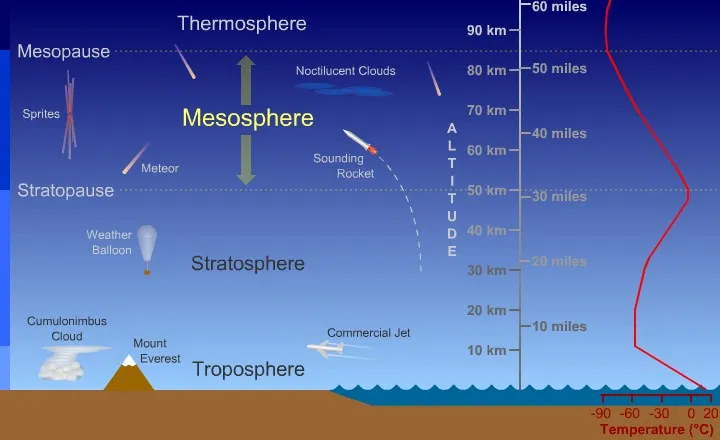
- The upper thermosphere is also where the bright night time displays of colors and flashes known as the aurora occur. The aurora are caused by energetic particles emitted by the sun. These particles become trapped by Earth’s magnetic field and collide with the relatively few gas atoms present above about 60 mi (100 km), mostly atomic oxygen (O) and nitrogen gas (N2). These collisions cause the atoms and molecules to emit light, resulting in spectacular displays.
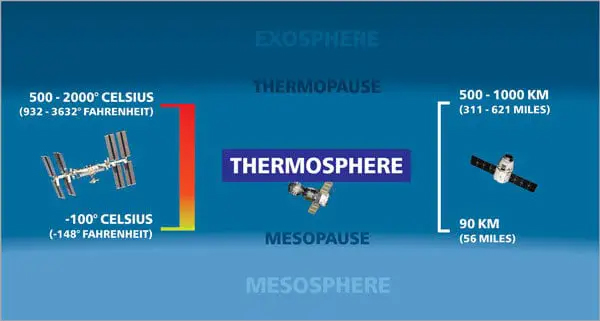









 Latest News
Latest News General Studies
General Studies